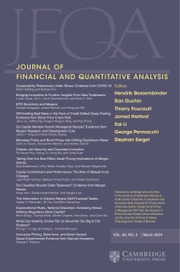No CrossRef data available.
Article contents
Optimal Ownership and Capital Structure with Agency Conflicts
Published online by Cambridge University Press: 19 November 2025
Abstract
We develop a continuous-time model examining agency conflicts among controlling shareholders (managers), minority shareholders, and creditors in corporate investment decisions. The manager’s private benefits encourage overinvestment, while their equity stake and debt overhang lead to underinvestment. We show these offsetting incentive effects can achieve optimal investment timing under certain conditions. Agency costs exhibit U-shaped relationships with private benefits, tax rates, volatility, managerial ownership, and leverage. The model reveals how the interplay among agency conflicts, tax benefits, and bankruptcy costs shapes optimal ownership and capital structure, explaining several documented empirical patterns in corporate finance.
Information
- Type
- Research Article
- Information
- Copyright
- © The Author(s), 2025. Published by Cambridge University Press on behalf of the Michael G. Foster School of Business, University of Washington
Footnotes
We thank David Mauer (the referee) and Jarrad Harford (the editor) for constructive and detailed feedback, comments, and suggestions that significantly improved the article. We thank Christian Ewald, Chao Ying, Mogens Steffensen, Khine Aye Myat Kyaw, and Jun Yu, as well as the participants at the University of Copenhagen, NTNU Business School, Umeå University, Southwestern University of Finance and Economics, Zhongnan University of Economics and Law, and Anhui Polytechnic University for their helpful comments. Yang and Zhu acknowledge the financial support from the National Natural Science Foundation of China (Grant Nos. 72031003, 723B2009, and 72432005) and the China Scholarships Council (Grant No. 202308440548). The work was finished while Zhu was a Ph.D. student at the Southern University of Science and Technology. Earlier versions of this article were circulated under the titles “Overcoming Agency Conflicts and Realizing First-Best Corporate Financial Policies” and “Optimal Ownership and Capital Structure with Agency Conflicts and Debt Renegotiation.” All errors are our own.

